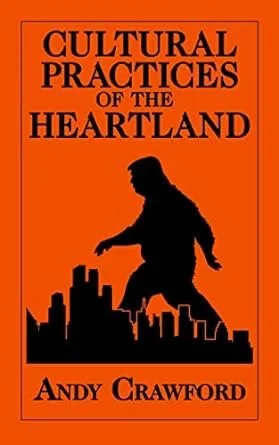SPSFC 3 Author Interview - Andy Crawford
1. What inspired the world, characters, or core concepts of your story? Was it a particular event, piece of media, or a speculative scientific idea?
It was a particularly vivid dream I had. In the dream, a recent American president was not a president or even a person but an enormous, Godzilla-sized monster, tromping across the landscape. And he’d captured the attention of the entire country, inspiring awe and even worship. This image stuck with me, and inspired the story that became CULTURAL PRACTICES OF THE HEARTLAND, satirizing the ridiculousness of American politics since 2016.
1. How did you approach the creation of your main characters? Were they modeled after real-life figures, or did they evolve organically as you explored the world of your story?
The monster, Rumpke, was quite clearly modelled after the aforementioned American president. I don’t want to give too much away from my book, so I’ll just say his most visceral characteristics are inspired by this person. And most of the political figures in my novel are inspired by real world American politicians – readers who follow American politics might enjoy matching each of these characters to their real-world counterparts. The other main characters, journalists and scientists, are not inspired by specific real-world figures, though may be influenced by the most admirable from those professions.
2. Science fiction often delves into questions of ethics, technology, and humanity. What central theme or moral question does your story grapple with, and why did you feel it was essential to explore?
The central theme is the insanity of recent American politics. I certainly don’t have an answer, or a path to get out of it, but I’m hopeful my book does a good job of portraying this craziness in a fun, sci-fi way, as well as demonstrating some of the motivations that keep it going. As an avid “pol” myself, and an American voter, I’m alternately horrified and amused by American politics as of late, and this book is one of the ways I’ve processed it in my own head. While it’s so often crazy and even scary, we can have some fun with it too!
3. How did you approach the integration of futuristic technology or scientific concepts in your story? Did you base them on existing theories or let your imagination run wild?
I spend a little time exploring the “science” behind the sci-fi elements (chiefly the existence of an enormous monster), and have some fun with the process of how the modern scientific establishment might approach such a subject in the real world, but I certainly wouldn’t say that the science of my story is strong! CULTURAL PRACTICES OF THE HEARTLAND is definitely on the “wild and wacky” side of sci-fi in terms of scientific accuracy.
4. The sci-fi genre provides a canvas to depict diverse cultures, species, and worlds. How have you incorporated representation and diversity in your work, and why do you think it's vital for the future of science fiction?
With my characters, I try to demonstrate the diversity within America, racially and ethnically as well as in gender, gender identity, sexuality, and (critically in modern times) national origin. Immigrants are such a huge and positive part of American society and life that I think it’s important to depict them in a positive way. Tolerance and a welcoming attitude aren’t just important for sci-fi, but for every aspect of life.
5. Every author has a unique writing process. Can you share a bit about yours? How do you manage world-building, plot progression, and character dynamics in such a complex genre?
For most of my novels, I spent months plotting the stories, and building the worlds, in advance with detailed notes. This one stayed in my head the entire time and I just started writing. The world building was much easier, since it takes place in an alternate version of the real world, with the major difference being the existence of the monster central to the story. Other than the writing itself, the most work required was mapping the physical and geographical journey the monster takes – the story is, in part, a road trip story, and I made a point that every place the monster and characters go were real towns in America. Even the diners, restaurants, and hotels they stay in were real places, and I did my best to portray these places as accurately as possible.
6. What's next for you after SPSFC? Are there any upcoming projects you can share with us?
With a toddler at home, it was a miracle that this book got written! I’m not currently working on any new projects, but I am tinkering with the idea of translating CULTURAL PRACTICES OF THE HEARTLAND into a visual medium like a graphic novel. The images it inspires in my head are so compelling that I really want to see what the monster, and its antics, might look like!


